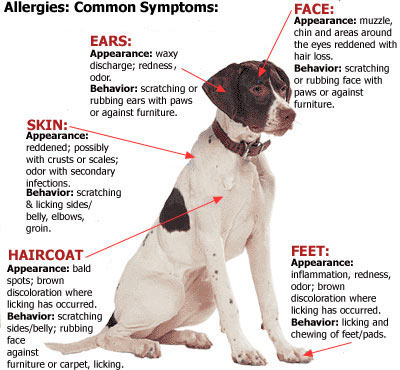Allergies can be one of the most frustrating conditions pet
owners face. Many times there are no cures, just management. While we can
control the food and flea exposures it is extremely difficult to control
environmental allergies. Atopic Dermatitis (or atopy) is allergies to
environmental agents. When we talk about the environmental allergens these can
range from pollens, to dust mites, to animal dander (yes, dogs can be allergic
to cats too!), and mold. It is nearly impossible to avoid contact with these,
however when we know what the specific allergy is we can try to minimize
contact.
Typically atopy will begin with younger dogs, but again can
be seen across all age groups. Symptoms
include intense itching, reddening of the skin, increased pigment (or coloring)
of the skin, and hair loss. The areas most commonly affected are feet, face and
under portion of the body. The skin may also become very thickened in these
places as well. Depending on the allergen the symptoms may occur seasonally.
Dust mites and other pet dander however may be present year round.
A diagnosis cannot be made on symptoms alone. Many other
conditions need to be ruled out first. Typically a full work up will be needed.
This could include skin scraping to rule out mites, cytology to assess for
bacterial or yeast infections as well as blood work to ensure there are no
other underlying causes. It is definitely possible to have more than one
condition going on at the same time. Without treating any underlying or
secondary diseases it will be difficult to resolve the symptoms.
Allergy testing is the only way to determine what a pet is
allergic to. There are two different methods of testing. One is very similar to
people which is called intradermal skin testing. This is where small amounts of
allergens are injected under the skin and then evaluated for response. If there
is a large response the patient is considered allergic to that material. The
downside of this procedure is that patients must be sedated and a large area
must be shaved. The advantage is that this testing is usually very accurate.
Another form of testing is a blood sample that can be submitted for analysis.
This is becoming more accurate over time but still is not quite as accurate as
skin testing. The advantage is that most general practices can perform this
test and patients do not have to be sedated. The disadvantage is that many
times this will not always indicate if the animal is actually allergic to the
material or just showing a large amount of exposure.
**Next week we will pick up with what to do after allergy testing.**



No comments:
Post a Comment